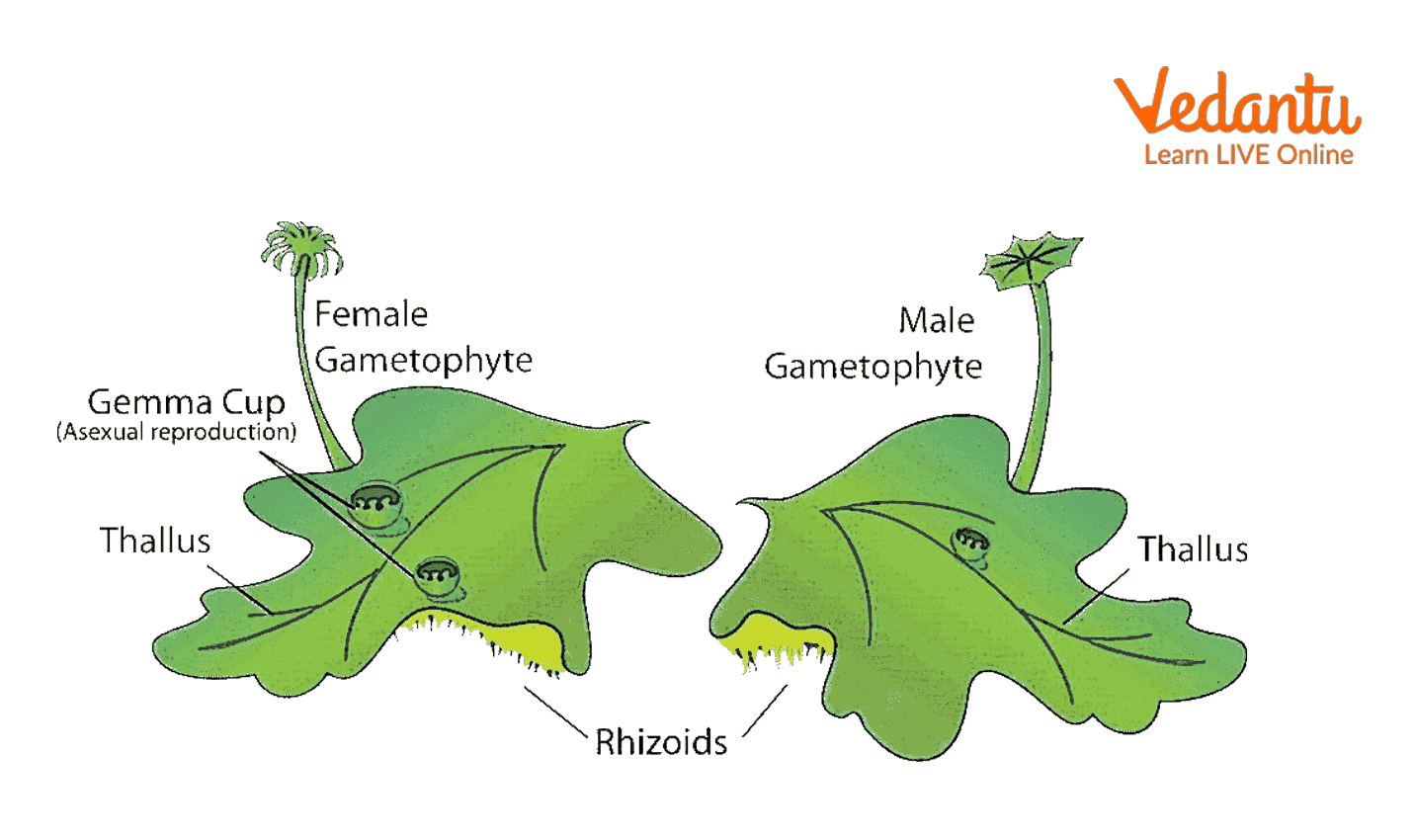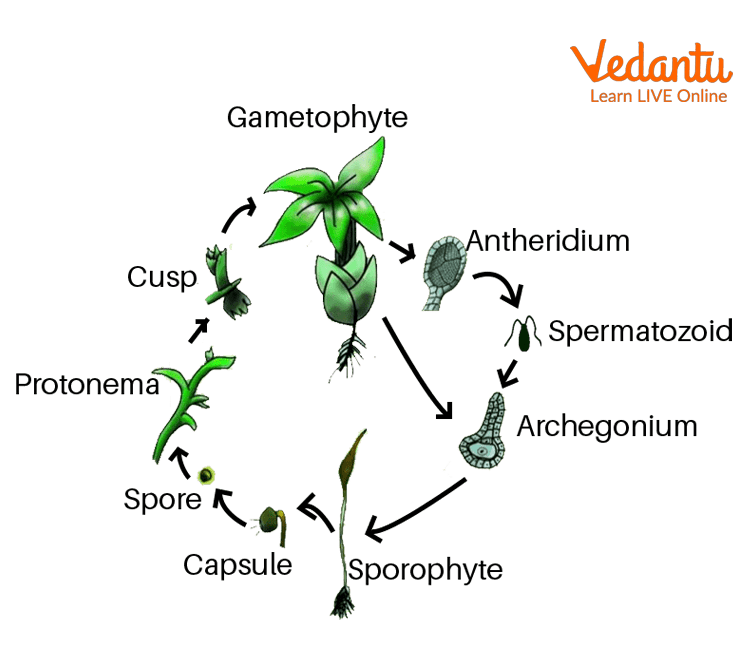What is Archegonium? Key Features and Its Role in Plant Reproduction
Reproduction in living things can be followed by methods of sexual reproduction, asexual reproduction, or both. Plants like mosses and ferns, which are non-flowering plants, do not produce pollens for sexual reproduction.

Archegonia
The archegonium and the antheridium are the female and male components, respectively, that they use for sexual reproduction. To understand the complex functionality and structure of archegonium, read through the article until the end.
What is Archegonia?
The flask-like female sex structure, found in several ferns, mosses, and some bryophytes, is known as archegonium. Marchantia lacks archegonium, even though it is a bryophyte.
The plants that reproduce using archegonia are called archegoniate. A single plant contains more than one archegonium. Thus, when we refer to the group of archegonium in a plant, we call it archegonia.
There is no particular placement for archegonia inside a plant. Archegonia inside hornworts are well embedded, whereas they are frequently found on the thallus surface of plants.
Structure of Archegonium
The structure of archegonia is flask-shaped. Archegonia are attached by the base of the gametophyte from which they develop. The female gamete or egg will be generated and matured inside the centre which is the swollen section of an archegonium.

Structure of Archegonium
The archegonium's neck extends upwards from the centre. Just before the neck is prepared to perform its job, the archegonium must reach maturity. The neck is initially made up of a lot of cells, which gives it a sturdy structure. The cells in the inside part of the neck will disintegrate when the archegonium reaches maturity and create a pathway to the egg.
Fertilisation takes place inside the archegonium itself. The fertilised egg will stay in the archegonium until it becomes a sporophyte, where it will then depart.
Sexual Reproduction in Bryophytes
Since bryophytes can grow on land yet require water for sexual reproduction, these plants are often known as amphibians of the plant kingdom.
It is referred to as a gametophyte because it produces gametes. Bryophytes have multicellular sex organs- archegonium and antheridium.
After being introduced to water, the antherozoids come across the archegonium. The zygote is created when the egg and an antherozoid combine. Zygotes do not instantly go through cell division. They create a sporophyte, a multicellular organism.
The photosynthetic gametophyte is the only source of nutrition for the sporophyte. To create haploid spores, some of the sporophyte's cells go through reductive division. These spores create gametophytes after they mature. Bryophytes are mainly divided into two categories:
1. Liverworts
In liverworts, asexual reproduction occurs either by thalli breakage or through the development of unique structures known as gemmae.
Gemmae are multicellular asexual buddings that grow in tiny containers called gemma cups. The gemmae separate from the parent and begin to grow into a new body.

Liverwort Structure
Male and female sex parts are generated on either the same or distinct thalli during sexual reproduction.
A foot, seta, and capsule are the three distinct parts of the sporophyte. Spores are formed inside the capsule following meiosis. These spores grow into gametophytes, which are free-living organisms.
2. Mosses
The gametophyte is the main stage of a moss's life cycle, which has two stages—the protonema stage and the leafy stage. In the leafy stage, along with the lateral bud, the sex organs develop.
In mosses, vegetative reproduction occurs by protonema fragmentation and budding.
The sex organs antheridia and archegonia are generated at the tip of the leafy branches during sexual reproduction. A sporophyte is what the zygote eventually becomes after ovulation.
Mosses have more complex sporophytes than liverworts do. Spores, which are created following meiosis, are present in the capsule.
Sexual Reproduction in Pteridophytes
The main plant body of pteridophytes bears sporangia. By meiosis in the spore parent cells, the sporangia create spores. The spores develop into prothallus, which are tiny, discrete, multicellular thalloid gametophytes.
The gametophytes have antheridia and archegonia. The transmission of the male gametes discharged from the antheridia to the opening of the archegonium requires the presence of water.

Pteridophyta
The zygote is created when the male gamete fuses with the egg that is already inside the archegonium. A multicellular, well-differentiated sporophyte, which is the main phase of the pteridophytes, is then produced by the zygote.
Nephrolepis
One major subgroup of pteridophytes is Nephrolepis. It develops new buds to reproduce vegetatively. The normal height of a Nephrolepis plant can be up to 4 feet. It uses spores to sexually reproduce.
The spores are created in distinctive sporangia, which are spore sacs. The bottom part of fertile pinnae known as sporophylls is where the sporangia are carried. All pinnae in mature plants are sporophylls, but those in immature plants lack sporangia and are sterile.
Sexual Reproduction in Gymnosperms
Gymnosperms do not have independent male and female gametophytes. They remain intact inside the sporangia already present on the sporophytes. There is archegonia inside the ovule in cycas. The microsporangium releases the pollen grain. The aperture of the ovules transported by megasporophylls is where they make contact after being carried by air currents. The pollen tube with the male gametes develops in the ovules towards the archegonia and releases its contents close to the archegonia's opening. The zygote transforms into an embryo following implantation, and the ovules transform into seeds.
Interesting Facts
Moss is the oldest type of plant, and they do not have roots.
They play a very important role in temperature regulation.
Some bryophytes are also used as packing material as they have the property of water holding.
They are also used in peat formation, which is used as fuel.
Important Questions
Q1. Archegonium is the sex organ of which plants?
Ans: Archegonium is the female sex organ of bryophytes, pteridophytes, and gymnosperms. This female sex organ contains the female gamete the ovum.
Q2. Reductive division in moss takes place in which part of the plant?
Ans: In bryophytes, zygote develops into a sporophyte and it has three important parts- foot, seta, and capsule. Reduction division takes place in a capsule to form a large number of capsules.
Q3. What is the function of archegonium?
Ans: The archegonium is a female sex organ in nonflowering plants. It houses the egg which is a female gamete. After fertilisation, it develops into a zygote.
Q4. Which acid is found in archegonia?
Ans: Archegonia is a female sex organ of several plants, after maturation it produces malic acid, which helps in the attraction of antherozoids.
Practice Questions
Explain Nephrolepis diagram.
What is the normal height of Nephrolepis?
What are the different characteristics of moss?
Which plant has archegonia inside the ovule?
Key Features
We conclude that an archegonium in a plant serves as the female organ for sexual reproduction.
It can be identified because of how much it resembles a lab flask in shape.
Additionally, fertilisation occurs inside the archegonium. These are generally found in bryophytes and pteridophytes, but they can be found in some gymnosperms also.


FAQs on Archegonium: Structure, Function, and Importance
1. What is the primary function of the archegonium in plants?
The primary function of the archegonium is to produce and protect the female gamete, or egg cell. It serves as the site of fertilisation, where the male gamete fuses with the egg. Following fertilisation, it also protects and nourishes the developing zygote and young embryo (the initial stage of the sporophyte generation).
2. How is a typical archegonium structured?
A typical archegonium is a flask-shaped structure consisting of two main parts. The upper, elongated part is the neck, which contains neck canal cells that disintegrate upon maturity to create a passage for male gametes. The lower, swollen part is the venter, which encloses the venter canal cell and the large, non-motile egg cell. The entire structure is protected by a layer of sterile jacket cells.
3. What is the difference between an archegonium and an archegoniophore?
The archegonium is the individual female reproductive organ that contains the egg cell. The archegoniophore, on the other hand, is a specialised, stalk-like structure found in some liverworts (like Marchantia) that bears a group of archegonia at its apex. Essentially, the archegonium is the organ, while the archegoniophore is the structure that holds the archegonia.
4. In which plant groups is the archegonium found?
Archegonia are characteristic features of several major plant groups, collectively known as Archegoniates. These groups include:
- Bryophytes (e.g., mosses, liverworts, and hornworts)
- Pteridophytes (e.g., ferns and horsetails)
- Gymnosperms (e.g., conifers, cycads, and Ginkgo)
5. How does the archegonium's role differ between bryophytes and gymnosperms?
While its core function remains the same, the archegonium's structure is more prominent in bryophytes and becomes progressively reduced in more advanced plants like gymnosperms. In bryophytes, it is a distinct, well-developed structure on the gametophyte. In gymnosperms, the archegonium is much smaller, often lacking a distinct venter, and is deeply embedded within the female gametophyte (endosperm) inside the ovule, making it less independent.
6. Why is the archegonium considered a crucial evolutionary adaptation for land plants?
The archegonium represents a key adaptation for terrestrial life. Unlike algae, which release gametes into water, land plants needed to protect their egg from desiccation (drying out) and physical damage. The sterile jacket of cells surrounding the archegonium provides this protection. It creates a safe, moist chamber for fertilisation and for the early development of the embryo, ensuring reproductive success in a dry land environment.
7. How can you differentiate between an archegonium and an antheridium?
An archegonium and an antheridium are the female and male reproductive organs, respectively. Key differences are:
- Function: The archegonium produces a single, non-motile egg, while the antheridium produces numerous, motile antherozoids (sperm).
- Structure: The archegonium is typically flask-shaped with a neck and a swollen base (venter). The antheridium is usually a stalked, globular or club-shaped structure.
- Gamete: The archegonium houses the large female gamete, whereas the antheridium contains many small male gametes.










